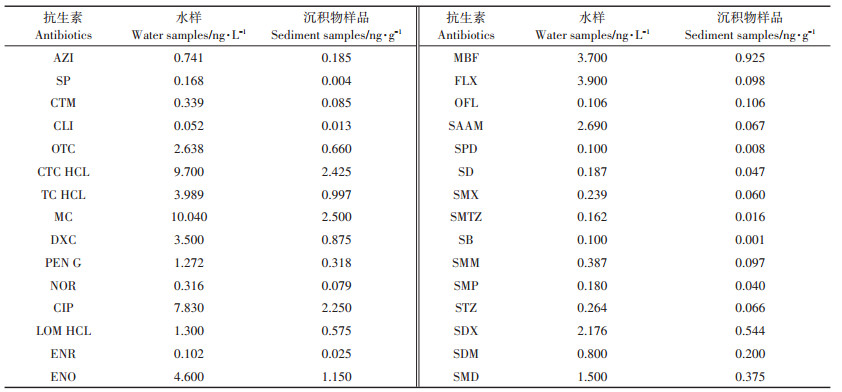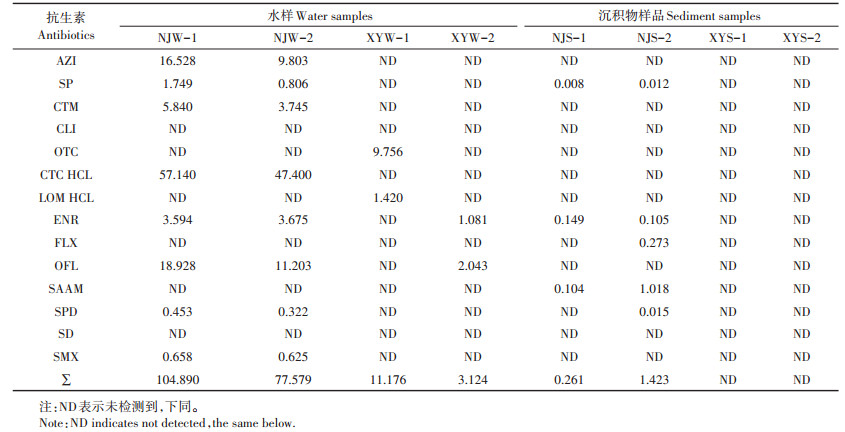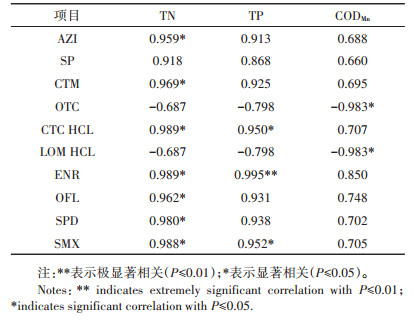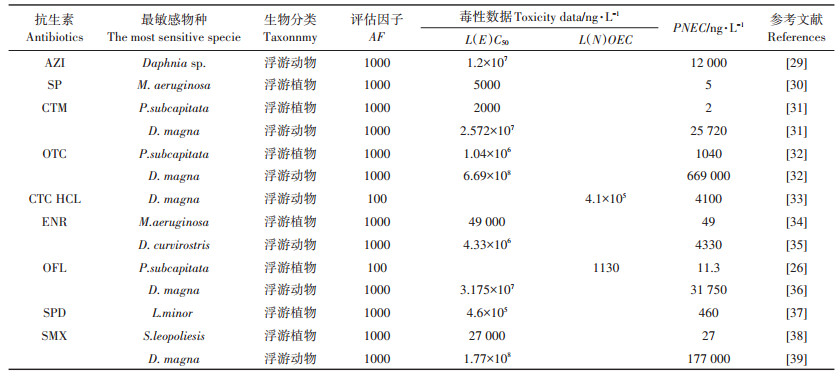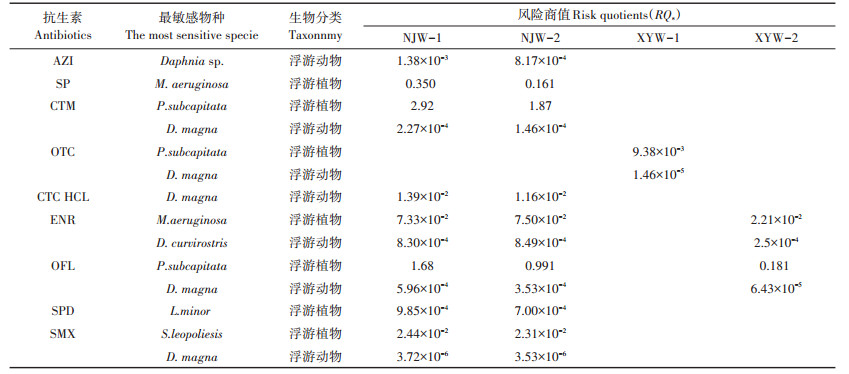2. 生态环境部南京环境科学研究所, 南京 210042
2. Nanjing Institute of Environmental Sciences, Ministry of Ecology and Environment, Nanjing 210042, China
近年来,水产养殖成为我国水产品产量增长的主要来源[1],约占全球水产养殖总量的71%[2]。克氏原螯虾作为我国广泛流行的淡水产品,近年来养殖面积和产量快速增长。江苏是我国主要水产养殖省份之一,2017年克氏原螯虾养殖面积达9.21×108 m2,产量高达1.154×105 t [3]。
在高密度的养殖活动中,抗生素通常直接或与饲料一起施用于养殖塘中,以提高养殖物种的健康状况和改善水产养殖系统的环境条件[4]。大多数水产养殖系统与周围水体相互连接并产生连续或间歇的废水排放[5],残留的抗生素最终可能会释放到周围水生生态系统中。据估计,饲料中约75%的抗生素通过养殖物种的排泄物和未经处理的含药饲料浸出进入环境[6]。一般而言,残留抗生素对微生物(藻类)的毒性较大,对养殖物种(无脊椎动物和鱼类)没有特别的毒性[7-8]。但藻类是食物链的基础,其产量减少将影响整个水生生态系统,对养殖物种造成间接影响。除此之外,水产养殖中抗生素的使用是扩大抗生素耐药性的重要途径[9]。来自水产养殖环境中残留抗生素的持续选择压力可能诱导产生抗性细菌和抗性基因(Antibiotic resistance genes,ARGs),并且极有利于ARGs在不同微生物之间的水平基因转移(Horizontal gene transfer,HGT)。据报道,水产养殖场所中ARGs的传播与抗生素浓度之间存在显著相关性[10]。水生环境中细菌与鱼类,甲壳类和人类病原体共享遗传相关的质粒,整合子和转座子等移动遗传元件,加剧了新型抗性细菌的出现以及ARGs向动物和人类群体的传播,对人类健康造成威胁[4, 9, 11]。为了预防或减少抗生素污染可能造成的环境负担和对水产养殖业的影响,首先要量化水产养殖环境中的抗生素浓度。目前关于抗生素的研究主要集中在河流、湖泊等环境水体中[12-14],虽然有几项研究关注水产养殖环境中的抗生素[15-16],但尚未有关于克氏原螯虾养殖环境中抗生素定量分析的公开报告。作为全国克氏原螯虾五大主要产地之一[3],研究江苏省克氏原螯虾水产养殖环境中抗生素的污染特征和生态风险具有重要意义。
本研究以江苏典型克氏原螯虾养殖区为研究对象,调查了5类(大环内酯类MCs、四环素类TCs、β-内酰胺类LCs、喹诺酮类QNs和磺胺类SAs)30种抗生素在养殖区水和沉积物中的浓度水平,揭示其分布特征和污染现状,评价其潜在风险,旨在为我国克氏原螯虾养殖区抗生素规范化使用提供基础理论依据。
1 材料与方法 1.1 试验试剂根据水产养殖中抗生素使用的规范和经验选择30种目标抗生素,包括MCs:阿奇霉素(AZI)、螺旋霉素(SP)、克拉霉素(CTM)、克林霉素(CLI);TCs:土霉素(OTC)、盐酸金霉素(CTC HCL)、盐酸四环素(TC HCL)、甲烯土霉素(MC)、盐酸强力霉素(DXC);LCs:青霉素G钠盐(PEN G);QNs:诺氟沙星(NOR)、环丙沙星(CIP)、盐酸洛美沙星(LOM HCL)、恩诺沙星(ENR)、依诺沙星(ENO)、麻保沙星(MBF)、氟罗沙星(FLX)、氧氟沙星(OFL);SAs:乙酰磺胺(SAAM)、磺胺吡啶(SPD)、磺胺嘧啶(SD)、磺胺甲恶唑(SMX)、磺胺甲二唑(SMTZ)、苯甲酰磺胺(SB)、磺胺间甲氧嘧啶(SMM)、磺胺甲氧哒嗪(SMP)、磺胺噻唑(STZ)、磺胺间二甲氧嘧啶(SDX)、磺胺邻二甲氧嘧啶(SDM)、磺胺对甲氧嘧啶(SMD)。均购自美国Sigma公司,纯度大于98%。
甲酸、乙腈、甲醇为色谱纯;磷酸、磷酸二氢钾(KH2PO4)、乙二胺四乙酸二钠(Na2EDTA)为分析纯;其他试剂为优级纯;试验用水为超纯水。
1.2 样品采集选定的采样点为江苏省南京浦口(NJ1,118°50′ 59″ E,32°10′ 56″ N和NJ2,118°51′ 34″ E,32°11′ 7″ N)和淮安盱眙(XY1,118°31′ 2″ E,32°57′ 35″ N和XY2,118°33′38″E,32°45′14″N)4个典型克氏原螯虾养殖塘,养殖面积分别为1.47×104、1.33×104、4×104 m2和1.33×104 m2,采样时间分别为2018年11月和2019年5月。使用“五点取样法”,分别采集每个养殖塘四周和中央的表层(0.5 m)水样,混匀后取2 L保存于棕色玻璃瓶中;同时利用底泥采样器(常州普森PSC- 200)采集表层沉积物(0~1 cm)装入样品袋。所有样品采集后低温保存,48 h内完成预处理和水样理化指标分析。
1.3 样品预处理及检测水样通过0.22 μm水相滤膜(GTTP04700,美国Merck Millipore公司),过滤后量取500 mL,加入2.5 mL 100 g·L-1 Na2EDTA溶液,用(1+1)磷酸溶液调节pH=3.0,充分混匀后用Oasis HLB固相萃取柱(500 mg,6 mL)进行富集。HLB柱使用前依次用6 mL甲醇、3 mL超纯水和6 mL KH2PO4溶液(pH=3.0)进行活化平衡。水样通过HLB柱时流速约为4 mL·min-1。萃取结束后,用6 mL超纯水淋洗HLB柱,在负压下抽干20 min,用6 mL甲醇洗脱。
沉积物样品室内风干粉碎并过60目筛后,称取4 g于100 mL离心管中,分别加入5 mL 0.1 mol·L-1 Na2EDTA溶液和25 mL提取液(0.2 mol·L-1柠檬酸缓冲液:甲醇=1:1,V:V)。依次超声15 min,振荡10 min,离心15 min(8000 r· min-1),重复3次并收集上清液,用超纯水定容至500 mL。参照水样预处理进行萃取和洗脱。
在35 ℃水浴下用氮吹仪将洗脱液吹至近干,用甲醇定容至1 mL。经0.2 μm滤膜过滤后转移至棕色进样小瓶,利用超高效液相色谱-串联质谱仪(LCAgilent Technologies 1290 Infinity,美国MS - AB SCIEX QTRAP 4500,美国Agilent公司)进行测定。样品经Agilent ZORBAX Eclipse Plus C18色谱柱(150 mm×2.1 mm,3.5 μm)分离,流动相A为0.2%甲酸溶液,B为乙腈溶液,柱温40 ℃。电离源采用电喷雾(ESI)离子源正电离模式,多反应离子监测(Multiple reaction monitoring,MRM)扫描定量分析目标抗生素。电离电压为5500 V;气帘气压为206 851.8 Pa;辅助加热气压为275 802.4 Pa;喷雾电压为241 327.1 Pa;碰撞气压为41 370.36 Pa;离子源温度为400 ℃。
1.4 质量控制采用外标法定量分析养殖区水和沉积物中目标抗生素的浓度,试验数据的获得均经过严格的QAQC程序。以水和沉积物样品为基底进行加标回收,抗生素回收率均在70%~120%之间。以信噪比S/N≥ 3时各目标抗生素的质量浓度作为检出限,水样和沉积物样品的检出限分别为0.102~10.040 ng · L-1和0.001~2.500 ng·g-1(表 1)。
|
|
表 1 水样和沉积物样品中抗生素的检出限 Table 1 The limits of detection of antibiotics in water and sediment samples |
分别利用国家标准方法测定水样的理化性质,包括总氮(TN,GB 11894—1989)、总磷(TP,GB 11893— 1989)和高锰酸钾指数(CODMn,GB 11892—1989)。
1.6 数据分析利用Minitab 17.1软件,分析水样中抗生素浓度和水体理化指标的Pearson相关系数。
1.7 抗生素生态风险评估风险商值(Risk quotients,RQs)被广泛应用于分析废水和地表水中常检测到的药物环境风险[17]。遵循RQs法评估克氏原螯虾养殖水体中残留抗生素对水生生物的生态风险,风险等级依据其大小划分:RQs≥1表明抗生素暴露风险很高;0.1≤RQs < 1代表中等风险;RQs < 0.1表明对目标生物风险低。RQs的计算公式如下:
RQs=MEC/PNEC
式中:MEC 为抗生素的实测浓度,ng·L-1;PNEC 为预测无效应浓度,即其不会对生态环境产生不良影响的最大浓度,ng·L-1。PNEC 值通过将毒性数据除以评估因子(AF)计算。根据欧盟的技术指导文件,AF 根据毒性数据情况选取,当采用急性毒性数据L(E)C50 时,AF取值1000;当采用慢性毒性数据L(N)OEC时,AF 取值100[18]。本研究中目标抗生素的毒性数据和AF取值来源于相关文献,基于最坏情况考虑,筛选出最敏感水生物种的PNEC值以计算RQs。
2 结果与讨论 2.1 抗生素浓度水平所有样品中共检测到4类14种目标抗生素,包括大环内酯类(AZI、SP、CTM、CLI)、四环素类(OTC、CTC HCL)、喹诺酮类(LOM HCL、ENR、FLX、OFL)和磺胺类(SAAM、SPD、SD、SMX),它们在不同采样点水样和沉积物样品中的浓度如表 2所示,其余抗生素在各样本中的浓度均低于检测限。
|
|
表 2 水样和沉积物样品中抗生素的种类和浓度(ng·g-1) Table 2 Types and concentrations of antibiotics in water and sediment samples(ng·g-1) |
南京浦口克氏原螯虾养殖水体(NJW-1和NJW- 2)中抗生素总浓度分别为104.890 ng·L-1和77.579 ng·L-1,污染水平以CTC HCL > OFL > AZI > CTM > ENR > SP > SMX > SPD顺序降低。CTC HCL在两塘水样中以较高浓度存在(分别为57.140 ng·L-1和47.400 ng·L-1),对总抗生素的贡献大于其余抗生素之和。总体而言,四环素类药物在南京两个养殖塘水体残留的抗生素中占主导地位。Chen等[19]的研究表明,中国南方海陵岛海水养殖区水样中广泛检测到抗生素(ND~16 000 ng·L-1),主要类别同样是四环素类,但浓度水平相对高于本研究。克氏原螯虾通过直接或间接感染细菌、真菌等引发疾病,四环素类抗生素能够有效抑制或杀灭这些致病微生物,因此被广泛应用于养殖活动。对于盱眙克氏原螯虾养殖水体,XYW-1中仅检出OTC(9.756 ng·L-1)和LOM HCL(1.420 ng·L-1);XYW-2中两种喹诺酮类抗生素(ENR和OFL)被检出(1.081~2.043 ng·L-1)。说明盱眙养殖水体中残留的主要是四环素类和喹诺酮类抗生素。总的来说,浦口水体中抗生素总浓度相对高于盱眙,一方面可能受养殖者使用抗生素种类和剂量习惯的影响。另一方面可能与采集样品的季节差异有关,11月养殖者陆续投放克氏原螯虾幼苗,为了促进幼虾的生长发育,同时预防爆发大规模细菌性疾病导致的减产,施用抗生素成为一种高效手段。此外,阮悦斐等[20]发现冬季淡水养殖水体和沉积物中抗生素浓度总体上比夏季高,与本研究结果类似。夏季气温和水温升高,抗生素在环境中的降解效率可能随之增加,而冬季抗生素在水环境中相对稳定。两个采样点抗生素种类虽有所差异,但浓度均处于低水平。与天津近郊[20]、太湖周边[21]和珠江口岸[22]等其他淡水养殖环境相比,江苏(特别是盱眙)克氏原螯虾养殖水体中抗生素浓度较低。这种差异可能是由于养殖习惯以及抗生素使用方式和使用量不同。盱眙克氏原螯虾在江苏省甚至全国范围内广泛流行,深受消费者喜爱。克氏原螯虾养殖成为盱眙支柱型产业,为了规范生产行为,维护市场稳定,盱眙县农业委员会制订《盱眙县龙虾养殖投入品管理控制办法(试行)》,严格控制养殖过程中抗生素等药物的使用[23]。本研究结果表明,盱眙在克氏原螯虾安全生产方面的努力已初见成效。
对于沉积物样品,盱眙两个采样点未检测到任何目标抗生素。NJS-1和NJS-2仅检出少量抗生素残留,总浓度分别为0.261 ng·g-1和1.423 ng·g-1。值得注意的是,两养殖塘水样中残留一定浓度的CTC HCL,然而沉积物中并未检出,可能与其较高的溶解度有关。检出的SAs(SAAM和SPD)浓度范围为0.015 ~1.018 ng·g-1,与Chen等[16]的研究结果(0.1~0.8 ng·g-1)相似,表明磺胺类的沉积物吸附性能较弱。QNs有较强的吸附亲和力,更容易被吸附到沉积物上,因此其在中国广东(ND~446 ng · g-1)和珠江口(ND~153.06 ng·g-1)养殖区沉积物中浓度较高[22, 24]。然而,本研究中QNs的浓度范围仅为ND~0.273 ng·g-1,这种差异可能源于养殖过程中使用量的不同。总体而言,江苏克氏原螯虾养殖环境中抗生素污染水平较低。
2.2 水体中抗生素浓度与水质指标的关系抗生素作为一种痕量的有机污染物,在水体中易发生水解、光解和生物降解等迁移转化过程。以往研究表明,环境因素会影响抗生素在水环境中的降解速率[25]。为了探究江苏省克氏原螯虾养殖水体中检测到的10种抗生素与水质指标(TN、TP、CODMn)的关系,对其进行相关性分析。如表 3所示,AZI、CTM、CTC HCL、ENR、OFL、SPD、SMX的浓度与TN显著正相关;CTC HCL、ENR、SMX的浓度与TP显著或极显著正相关。水体富营养化程度的增加可能在一定程度上抑制以上抗生素药物(特别是CTC HCL、ENR、SMX)在养殖水环境中的降解。以往也有研究表明,水体中诺氟沙星(NOR)、甲氧苄胺嘧啶(TMP)、环丙沙星(CIP)、红霉素(ETM)的浓度与富营养化程度呈正相关[26-27]。水样中OTC和LOM HCL的浓度与CODMn显著负相关(表 3)。可能由于大量有机污染物在微生物作用下进行好氧分解,水中溶解氧不足,从而影响抗生素的微生物降解速率。不同的是,在秦延文等[26]的研究中,NOR、TMP、CIP浓度与有机污染程度呈极显著正相关,可能与抗生素不同的化学结构有关。然而,目前的研究尚不能揭示水体理化性质影响抗生素在环境中迁移扩散的机制。
|
|
表 3 抗生素浓度与水质指标相关性分析 Table 3 Correlations between antibiotic concentrations and water-quality indexes |
不同抗生素对应最敏感物种的PNEC 值如表 4所示,浮游植物对抗生素更为敏感。抗生素可能对浮游植物造成急性或慢性毒性威胁,从而对养殖塘和其他环境中的生物地球化学过程产生不利影响[21]。结果表明,大环内酯类对藻类生长最不利,其次是喹诺酮类。
|
|
表 4 目标抗生素毒性数据 Table 4 Aquatic toxicity data of target antibiotics |
结合检出的抗生素环境浓度(MEC)计算其在江苏克氏原螯虾养殖水体中的RQs(表 5),所有目标抗生素对浮游动物的生长几乎没有风险。NJ-1中CTM和OFL、NJ-2中CTM对藻类等浮游植物具有较高的生态风险;NJ-1中SP、NJ-2中SP和OFL处于中等风险水平。说明在南京浦口养殖区,大环内酯类和喹诺酮类抗生素存在一定生态风险。这两类抗生素在医药和农业养殖领域应用广泛,但与其他地区相比,本研究中其浓度均处于低水平,却呈现中高风险,表明这些抗生素即使在残留浓度很低的情况下,也会对生态环境造成威胁。在盱眙养殖环境中,仅XY-2中残留的OFL会造成中等程度的生态风险。此前报道了孟加拉国有鳍鱼类养殖地表水中除泰乐菌素(TYL,RQ=0.116)外,其余抗生素的风险商值均低于0.1,与本研究中盱眙克氏原螯虾养殖环境的抗生素生态风险水平相当[28]。此类中低风险与养殖过程中抗生素的规范化使用密不可分。水产养殖生产中使用大量化学品和生物制品,其中抗生素由于对非目标生物具有高毒性和生物累积性,并且可能潜在地影响邻近水生生态系统的生物多样性和功能,已被证明是对环境最有害的化合物之一[5]。减少养殖过程中抗生素的使用,能够有效降低其生态和人类健康风险。
|
|
表 5 目标抗生素对最敏感水生生物的风险商值 Table 5 RQs of target antibiotics to the most sensitive species |
(1)江苏(特别是盱眙)克氏原螯虾养殖水体中抗生素污染水平相对较低。CTC HCL、OFL、AZI是浦口养殖水中的主要抗生素。沉积物中仅有微量抗生素残留。
(2)基于计算RQs进行的风险评估表明,浦口养殖水体中SP、CTM和OFL可能对绿藻等浮游植物构成高风险或中度风险,盱眙残留抗生素对藻类的风险处于中低水平。
(3)有必要对水产养殖过程中抗生素的使用进行监督和控制,以减少抗生素对水生生物以及人类健康的潜在风险。
| [1] |
刘子飞, 赵文武. 我国水产养殖40年:改革、成效、问题与对策(上)[J]. 科学养鱼, 2018, 352(12): 7-9. LIU Zi-fei, ZHAO Wen-wu. Reform, effectiveness, problem and countermeasure during 40 years of aquaculture industry in China[J]. Scientific Fish Farming, 2018, 352(12): 7-9. |
| [2] |
Zhao Y, Zhang X X, Zhao Z, et al. Metagenomic analysis revealed the prevalence of antibiotic resistance genes in the gut and living environment of freshwater shrimp[J]. Journal of Hazardous Materials, 2018, 350: 10-18. DOI:10.1016/j.jhazmat.2018.02.004 |
| [3] |
郭志文. 探讨小龙虾养殖现状及发展趋势[J]. 渔业致富指南, 2019, 506(2): 14-16. GUO Zhi-wen. Discussion on the current status and development trend of crayfish farming[J]. Fishery Guide to be Rich, 2019, 506(2): 14-16. |
| [4] |
Henriksson P J G, Rico A, Troell M, et al. Unpacking factors influencing antimicrobial use in global aquaculture and their implication for management:A review from a systems perspective[J]. Sustainability Science, 2018, 13(4): 1105-1120. DOI:10.1007/s11625-017-0511-8 |
| [5] |
Rico A, Satapornvanit K, Haque M M, et al. Use of chemicals and biological products in Asian aquaculture and their potential environmental risks:A critical review[J]. Reviews in Aquaculture, 2012, 4(2): 75-93. DOI:10.1111/j.1753-5131.2012.01062.x |
| [6] |
Lalumera G M, Calamari D, Galli P, et al. Preliminary investigation on the environmental occurrence and effects of antibiotics used in aquaculture in Italy[J]. Chemosphere, 2004, 54(5): 661-668. DOI:10.1016/j.chemosphere.2003.08.001 |
| [7] |
Park S, Choi K. Hazard assessment of commonly used agricultural antibiotics on aquatic ecosystems[J]. Ecotoxicology, 2008, 17(6): 526-538. DOI:10.1007/s10646-008-0209-x |
| [8] |
Radka Zounková, Zdeňka Klimesová, Leona Nepejchalová, et al. Complex evaluation of ecotoxicity and genotoxicity of antimicrobials oxytetracycline and flumequine used in aquaculture[J]. Environmental Toxicology and Chemistry, 2011, 30(5): 1184-1189. DOI:10.1002/etc.486 |
| [9] |
Cabello F C, Godfrey H P, Buschmann A H, et al. Aquaculture as yet another environmental gateway to the development and globalisation of antimicrobial resistance[J]. Lancet Infectious Diseases, 2016, 16(7): E127-E133. DOI:10.1016/S1473-3099(16)00100-6 |
| [10] |
Shah S Q A, Cabello F C, L'Abée-Lund T M, et al. Antimicrobial resistance and antimicrobial resistance genes in marine bacteria from salmon aquaculture and non-aquaculture sites[J]. Environmental Microbiology, 2014, 16(5): 1310-1320. DOI:10.1111/1462-2920.12421 |
| [11] |
Cabello F C, Godfrey H P, Tomova A, et al. Antimicrobial use in aquaculture re-examined:Its relevance to antimicrobial resistance and to animal and human health[J]. Environmental Microbiology, 2013, 15(7): 1917-1942. DOI:10.1111/1462-2920.12134 |
| [12] |
张晓娇, 柏杨巍, 张远, 等. 辽河流域地表水中典型抗生素污染特征及生态风险评估[J]. 环境科学, 2017, 38(11): 109-117. ZHANG Xiao-jiao, BAI Yang-wei, ZHANG Yuan, et al. Occurrence, distribution, and ecological risk of antibiotics in surface water in the Liaohe River Basin, China[J]. Environmental Science, 2017, 38(11): 109-117. |
| [13] |
丁惠君, 钟家有, 吴亦潇, 等. 鄱阳湖流域南昌市城市湖泊水体抗生素污染特征及生态风险分析[J]. 湖泊科学, 2017, 29(4): 848-858. DING Hui-jun, ZHONG Jia-you, WU Yi-xiao, et al. Characteristics and ecological risk assessment of antibiotics in five city lakes in Nanchang City, Lake Poyang Catchment[J]. Journal of Lake Sciences, 2017, 29(4): 848-858. |
| [14] |
Li W, Shi Y, Gao L, et al. Occurrence of antibiotics in water, sediments, aquatic plants, and animals from Baiyangdian Lake in North China[J]. Chemosphere, 2012, 89(11): 1307-1315. DOI:10.1016/j.chemosphere.2012.05.079 |
| [15] |
Huang L, Xu Y B, Xu J X, et al. Antibiotic resistance genes(ARGs) in duck and fish production ponds with integrated or non-integrated mode[J]. Chemosphere, 2017, 168: 1107-1114. DOI:10.1016/j.chemosphere.2016.10.096 |
| [16] |
Chen C Q, Zheng L, Zhou J L, et al. Persistence and risk of antibiotic residues and antibiotic resistance genes in major mariculture sites in Southeast China[J]. Science of the Total Environment, 2017, 580: 1175-1184. DOI:10.1016/j.scitotenv.2016.12.075 |
| [17] |
Hernando M D, Mezcua M, Fernández-Alba A R, et al. Environmental risk assessment of pharmaceutical residues in wastewater effluents, surface waters and sediments[J]. Talanta, 2006, 69(2): 334-342. DOI:10.1016/j.talanta.2005.09.037 |
| [18] |
European Commission. Technical guidance document in support of commission directive 93/67/EEC on risk assessment for new notified substances and commission regulation(EC)No 1488/94 on risk assessment for existing substance[M]. Luxembourg: Office for Official Publications of the European Communities, 2003.
|
| [19] |
Chen H, Liu S, Xu X R, et al. Antibiotics in typical marine aquaculture farms surrounding Hailing Island, South China:Occurrence, bioaccumulation and human dietary exposure[J]. Marine Pollution Bulletin, 2015, 90(1/2): 181-187. |
| [20] |
阮悦斐, 陈继淼, 郭昌胜, 等. 天津近郊地区淡水养殖水体的表层水及沉积物中典型抗生素的残留分析[J]. 农业环境科学学报, 2011, 30(12): 2586-2593. RUAN Yue-fei, CHEN Ji-miao, GUO Chang-sheng. Distribution characteristics of typical antibiotics in surface water and sediments from freshwater aquaculture water in Tianjin Suburban Areas, China[J]. Journal of Agro-Environment Science, 2011, 30(12): 2586-2593. |
| [21] |
Song C. Occurrence of antibiotics and their impacts to primary productivity in fishponds around Tai Lake, China[J]. Chemosphere, 2016, 161: 127-135. DOI:10.1016/j.chemosphere.2016.07.009 |
| [22] |
梁惜梅, 施震, 黄小平. 珠江口典型水产养殖区抗生素的污染特征[J]. 生态环境学报, 2013, 34(10): 304-310. LIANG Xi-mei, SHI Zhen, HUANG Xiao-ping. Occurrence of antibiotics in typical aquaculture of the Pearl River Estuary[J]. Ecology and Environmental Sciences, 2013, 34(10): 304-310. |
| [23] |
水产养殖网.关于印发《盱眙县龙虾养殖投入品管理控制办法(试行)》的通知[EB/OL].(2018-06-05)[2019-11-25]. http://www.shuichan.cc/news_view-360990.html. Aquaculture Network. Notice on the issuance of administrative measures for the control of lobster breeding inputs in Xuyi(Trial)[EB/OL]. (2018-06-05)[2019-11-25]. http://www.shuichan.cc/news_view-360990.html. |
| [24] |
Xiong W, Sun Y, Zhang T, et al. Antibiotics, antibiotic resistance genes, and bacterial community composition in fresh water aquaculture environment in China[J]. Microbial Ecology, 2015, 70(2): 425-432. DOI:10.1007/s00248-015-0583-x |
| [25] |
邓玉, 倪福全. 水环境中抗生素残留及其危害[J]. 南水北调与水利科技, 2011, 9(3): 96-100. DENG Yu, NI Fu-quan. Research on antibiotics residues and hazardous in aquatic environment:A review[J]. South-to-North Water Diversion and Water Science & Technology, 2011, 9(3): 96-100. |
| [26] |
秦延文, 张雷, 时瑶, 等. 大辽河表层水体典型抗生素污染特征与生态风险评价[J]. 环境科学研究, 2015, 28(3): 361-368. QIN Yan-wen, ZHANG Lei, SHI Yao, et al. Contamination characteristics and ecological risk assessment of typical antibiotics in surface water of the Daliao River, China[J]. Research of Environmental Sciences, 2015, 28(3): 361-368. |
| [27] |
魏红, 王嘉玮, 杨小雨, 等. 渭河关中段表层水中抗生素污染特征与风险[J]. 中国环境科学, 2017, 37(6): 2255-2262. WEI Hong, WANG Jia-wei, YANG Xiao-yu, et al. Contamination characteristic and ecological risk of antibiotics in surface water of the Weihe Guanzhong section[J]. China Environmental Science, 2017, 37(6): 2255-2262. DOI:10.3969/j.issn.1000-6923.2017.06.033 |
| [28] |
Hossain A, Nakamichi S, Habibullah-Al-Mamun M, et al. Occurrence, distribution, ecological and resistance risks of antibiotics in surface water of finfish and shellfish aquaculture in Bangladesh[J]. Chemosphere, 2017, 188: 329-336. DOI:10.1016/j.chemosphere.2017.08.152 |
| [29] |
Xue B M, Zhang R J, Wang Y H, et al. Antibiotic contamination in a typical developing city in South China:Occurrence and ecological risks in the Yongjiang River impacted by tributary discharge and anthropogenic activities[J]. Ecotoxicology and Environmental Safety, 2013, 92: 229-236. DOI:10.1016/j.ecoenv.2013.02.009 |
| [30] |
HallingSørensen B. Algal toxicity of antibacterial agents used in intensive farming[J]. Chemosphere, 2000, 40(7): 731-739. DOI:10.1016/S0045-6535(99)00445-2 |
| [31] |
Isidori M, Lavorgna M, Nardelli A, et al. Toxic and genotoxic evaluation of six antibiotics on non-target organisms[J]. Science of the Total Environment, 2005, 346(1/2/3): 87-98. |
| [32] |
Kolar B, Arnus L, Jeretin B, et al. The toxic effect of oxytetracycline and trimethoprim in the aquatic environment[J]. Chemosphere, 2014, 115: 75-80. DOI:10.1016/j.chemosphere.2014.02.049 |
| [33] |
Ji K, Kim S, Han S, et al. Risk assessment of chlortetracycline, oxytetracycline, sulfamethazine, sulfathiazole, and erythromycin in aquatic environment:Are the current environmental concentrations safe?[J]. Ecotoxicology, 2012, 21(7): 2031-2050. DOI:10.1007/s10646-012-0956-6 |
| [34] |
Robinson A A, Belden J B, Lydy M J. Toxicity of fluoroquinolone antibiotics to aquatic organisms[J]. Environmental Toxicology and Chemistry, 2005, 24(2): 423-430. DOI:10.1897/04-210R.1 |
| [35] |
Dalla Bona M, Di Leva V, De Liguoro M. The sensitivity of Daphnia magna and Daphnia curvirostris to 10 veterinary antibacterials and to some of their binary mixtures[J]. Chemosphere, 2014, 115: 67-74. DOI:10.1016/j.chemosphere.2014.02.003 |
| [36] |
杜雪.南昌市四种典型地表水体抗生素污染特征与生态风险评估[D].南昌: 南昌大学, 2015: 42-43. DU Xue. Contamination characteristics and risks assessment of antibiotics in four typical surface waters in Nanchang, Jiangxi Provence[D]. Nanchang: Nanchang University, 2015: 42-43. http://cdmd.cnki.com.cn/Article/CDMD-10403-1015627676.htm |
| [37] |
BialK-Bielin'Ska A, Stolte S, Arning J, et al. Ecotoxicity evaluation of selected sulfonamides[J]. Chemosphere, 2011, 85(6): 928-933. DOI:10.1016/j.chemosphere.2011.06.058 |
| [38] |
Ferrari B, Mons R, Vollat B, et al. Environmental risk assessment of six human pharmaceuticals:Are the current environmental risk assessment procedures sufficient for the protection of the aquatic environment?[J]. Environmental Toxicology and Chemistry, 2004, 23(5): 1344-1354. DOI:10.1897/03-246 |
| [39] |
Kim Y, Choi K, Jung J, et al. Aquatic toxicity of acetaminophen, carbamazepine, cimetidine, diltiazem and six major sulfonamides, and their potential ecological risks in Korea[J]. Environment International, 2007, 33(3): 370-375. DOI:10.1016/j.envint.2006.11.017 |
 2020, Vol. 39
2020, Vol. 39



